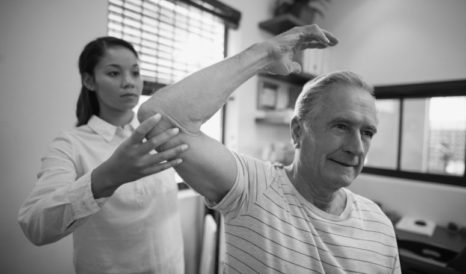When to Seek Treatment for Tennis Elbow
Tennis elbow is common in people who play a racquet sports, but can affect anyone who does repetitive motions using their forearm or wrist. Learn more.
 Tennis elbow causes pain on the outside of your elbow joint. It is common in people who play racquet sports, but can affect anyone who does repetitive motions using their forearm or wrist. It can be brought on by typing, painting or using a hammer or a screwdriver. Plumbers and gardeners are particularly at risk.
Tennis elbow causes pain on the outside of your elbow joint. It is common in people who play racquet sports, but can affect anyone who does repetitive motions using their forearm or wrist. It can be brought on by typing, painting or using a hammer or a screwdriver. Plumbers and gardeners are particularly at risk.
Many people try to go back to their activity after a brief period of rest, or simply take anti-inflammatories to reduce pain and swelling. However, this can worsen the problem in the long term.
Luckily, with the correct diagnosis, this type of elbow injury can be treated effectively, so you can get back to your sport or activity. So how do you know when to seek treatment for tennis elbow?
What is tennis elbow?
Your forearm muscles are attached to your elbow joint by tendons. It is these tendons that can get inflamed and partially torn, leading to tennis elbow.
Most people who get tennis elbow are between 30 and 50 years of age, and it affects men and women equally.
What are the symptoms of tennis elbow?
The pain is usually quite mild at first, and then builds up over a few weeks to a severe and debilitating pain. It occurs on the outside of your elbow joint, particularly when:
- Lifting or bending your arm
- Twisting your forearm
- Gripping small objects such as a pen or cup
- Fully straightening your arm
It can also lead to persistent pain on the outside of your forearm just below your elbow – sometimes radiating down towards your wrist.
When should I see a doctor for tennis elbow?
The sooner, the better.
When you begin to feel the symptoms listed above, I would suggest you contact your doctor to make sure you get the right treatment.
Will tennis elbow get better on its own?
Many people blame the symptoms of tennis elbow on their age, and assume that with some rest, the condition will go away.
I would always suggest getting a proper diagnosis to assess the problem and to rule out other conditions (tennis elbow can be worsened by degenerative bone disease such as arthritis, or by nerve disease).
You will be given a physical examination with specific tests to assess your pain levels and relative weakness in your forearm. Scans (x-rays for bones, MRI or ultrasound for soft tissue) are used to assess the severity of the condition.
How is tennis elbow treated?
Tennis elbow is initially treated with rest and anti-inflammatories to relieve pain and reduce swelling. You may need a brace to prevent you from using your muscle as the tendon heals.
Physical therapy can help restore pain-free range of motion in your elbow – you’ll usually be given a programme of stretching and strengthening exercises to do several times a day.
Steroid injections are used to help reduce inflammation and swelling. At the same time, the specialist may use the needle to stimulate a repair process.
PRP injections: this treatment involves injecting platelets and plasma from your own blood onto the damaged tendon to stimulate repair.
Some doctors opt for shockwave therapy: using targeted high energy sound waves to encourage healing in your tendon.
With non-surgical treatment, it can take a few weeks to recover – although in some cases, it can take several months.
In very rare cases, you may need surgery. This can involve repairing the damaged tendon, manipulating trapped or misaligned tissue in the joint or removing bony outgrowths. A tennis elbow operation is usually carried out arthroscopically – using small cuts and tiny instruments.
As with most joint problems, getting an accurate diagnosis is vital for treatment and recovery. So many people try to resolve issues on their own without having a clear idea of the problem they are self-treating. This often ends up leading to far more severe conditions with longer recovery times.
Simon Moyes is an internationally renowned orthopaedic surgeon and leader in the field of arthroscopic (keyhole) surgery. His Capital Orthopaedics team works from The Cromwell Hospital in London, with its state-of-the-art diagnostic and surgical equipment, and top sports medicine professionals.
